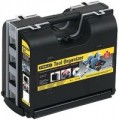Suitable for
The type of tool for which the container is normally intended.
—
For hand tools. Products intended primarily for hand tools - hammers, screwdrivers, pliers, etc. Such tools are relatively small in size and, most often, of a standard shape; so for such boxes there is no point in specifying compatibility (see below). Note that such products are not suitable for small items - so if you plan to work with a large amount of “small things”, it is worth finding a container that was originally designed for this (see below).
—
For tools and small items. Containers designed for both hand tools (see above) and for storing a large number of small parts. The specific design of such products may vary. Thus, in classic boxes (see “Type”), a cover with an organizer is most often provided for small items (see below); individual organizers for this purpose have compartments of different sizes; Vests and belt bags differ in size, respectively, pockets, etc.
—
Only for small elements. Containers intended only for small parts - fasteners (bolts, nuts, screws, nails), some types of working attachments (drills, bits), etc. The vast majority of such containers are classified as organizers (see “Type”), although there are and exceptions.
—
For power tools. Containers for this purpose are characterized by a high degree of
...specialization; they are usually made for specific models of power tools (see “Compatibility”). This is due to the fact that similar instruments (even of similar purpose and level) differ markedly in the general structure and arrangement of various structural elements. And even if compatibility for such a container is not indicated, most likely it is intended at least for equipment from a certain brand.Size
The main size of the container for tools. Inches are traditionally used for this designation, and the length is usually indicated as the main size. This information allows you to evaluate the "weight category" of the product as a whole, as well as to determine whether it is suitable for a particular instrument of large sizes. At the same time, the characteristics usually indicate the overall dimensions on all three main sides (in millimetres), however, it is more convenient for many craftsmen to use the size designation in inches.
For kits (see below), this paragraph indicates the dimensions of all containers supplied in the kit.
Sections
Design of movable sections mounted in a tool box or other container. A section is a separate movable unit, usually divided into several compartments (see above). The meaning of such blocks is to ensure the compactness of the container when folded and the convenience of access to the contents when unfolded. The types of sections can be as follows:
—
Sliding. Sections located at the top of the container and also playing the role of a cover for its lower part. Typically, such sections are made in pairs or quadruples, 2 pairs each, and when opened, in accordance with the name, they diverge in different directions, allowing you to get to the space below them. This variety is found mainly in boxes (see "Type").
—
Retractable. Sections that slide out of the inner volume of the container are like drawers in a desk or kitchen table. This design is used in organizers and
trolleys(see "Type").
Organizer slots
The number of individual cells provided in the organizer. In this case, we can talk about an organizer as a separate device (see "Type"), or a set of cells built into the lid of the box (see "Lid with an organizer"). And for solutions with removable partitions, in which cells can be combined, the maximum number is indicated — with all installed partitions.
Organizers, by definition, are designed mainly for small things. Therefore, the more cells there are, the more varieties of small items can be stored in a container. For example, in 10 cells you can keep bolts of five different sizes and separately nuts for them. Such a number of compartments —
up to 10 — is generally considered small, but in fact it is often quite enough.
11 – 20 cells can be called an average, and the most capacious organizers have
up to 30 compartments. However it is worth considering that with the same dimensions of the container, an increase in the number of cells leads to a decrease in their volume.
Adjustable compartment size
Possibility
to change the size of the compartments provided in the tool box. This function is mainly used in
organizers(see "Type"). Usually, the partitions in such products (all, or at least most) can be removed and rearranged, thus adjusting the size, number and even shape of the compartments — for example, to provide enough space for a relatively large tool like a screwdriver or pliers. Another option is
bags and
backpacks(see ibid.), in which individual compartments can grow and shrink through the use of zippers or zip ties. Here the meaning of this function is somewhat different: it is aimed at optimizing the use of internal space depending on the amount of content. For example, if there is little content, a bag or backpack can be “squeezed” so that things do not hang around the cabin; and when an additional load appears, loosen the ties or unzip, providing the necessary volume.

